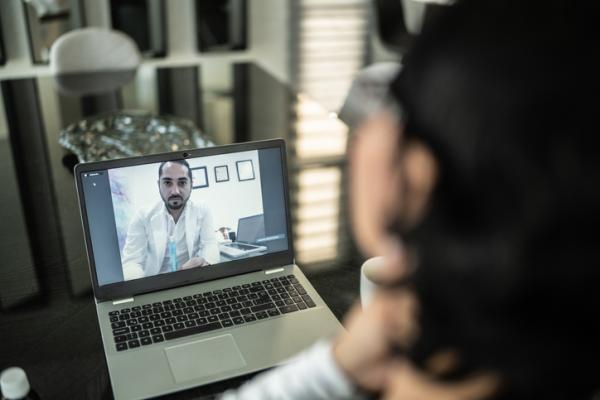
Getty Images
January 4, 2023 — Under the simultaneous pressures of a pandemic-driven explosion in the use of telehealth, a growing emphasis on value-based care, and the current state of medical technology, the healthcare industry is undergoing what appear to be fundamental changes as a consequence of the high and irreversible growth of telehealth. The evolution of medical technology enables effective virtual care in the home for patients with increasingly serious conditions. Stuart Long, CEO of InfoBionic, observes, "One of the most important lessons we learned is that telehealth and virtual care are really important augmentations to our healthcare matrix, and they’re here to stay.” InfoBionic is pioneering the first virtual care, hospital-grade telemetry platform capable of supporting low- to high-acuity cardiac patients anywhere virtual care is delivered.
In December 2022, the American Medical Association (AMA), in partnership with Manatt Health, released the “Return on Health” report that develops a framework to more precisely and holistically measure the value of telehealth through detailed case studies. This initiative also focuses on the challenges and opportunities for virtual care.(1) The adoption of the latest technology is essential to the expansion of telehealth beyond routine patient care.
Long notes, “Where telehealth’s primary focus is on convenience, virtual care is focused on bringing the richness of healthcare to patients in a variety of settings, and harnessing technology to accelerate time to diagnosis and improve health outcomes. While the pandemic was an accelerator of this shift, cardiology was actually an early luminary in first demonstrating the value and potential of virtual models.”
Medicare visits conducted through telehealth increased 63-fold in one year, from approximately 840,000 in 2019 to 52.7 million in 2020. Though the Covid-19 pandemic primarily drove this increase, all indications are that extensive use of telehealth is now a permanent feature of the modern face of healthcare.(2) In 2021, 37% of adults in the United States used telehealth for appointments or communication with healthcare professionals.(3) After the initial adjustment period, providers and patients realized that the flexibility, convenience, and potential for cost savings make telehealth a valuable addition to the healthcare delivery system.
InfoBionic is developing a spectrum of devices capable of dealing with cardiology problems from the simplest to the most complex to create the hospital experience in a virtual-care world. InfoBionic’s MoMe ARC platform is remote monitoring designed for virtual cardiology. Long says, “Our vision is to support continuous monitoring in real-time to near real-time in hospital-to-home scenarios, that ensures complete data continuity with no compromises. We can monitor patients anywhere virtual care is delivered without missing a beat.”
Incorporating state-of-the-art remote patient monitoring technology within the virtual healthcare system can reduce the risk of avoidable hospital visits, extended stays, and readmissions. For every 500 high-risk Medicare patients with multiple chronic conditions, health systems can realize $5.2 million in annual cost savings.(4)
The emphasis of the AMA and Manatt framework for telehealth is not narrowly focused on cost savings; it measures the benefits of these additional value streams for healthcare providers and patients:(1)
1. Clinical outcomes, quality, and safety.
2. Access to care.
3. Patient and family experience.
4. Clinician experience.
5. Financial and operational impact.
6. Health equity.
Long remarks, “So, what’s next for virtual care? As providers navigate the new virtual care reality, cardiology is being called upon yet again to lead the way. What began as remote patient monitoring has been replaced by a powerful new model for virtual telemetry that enables high-integrity patient monitoring for a wide variety of virtual clinical use cases — from preventive care to advanced hospital-to-home scenarios.”
For more information: https://InfoBionic.com/
References:
1. “AMA Publishes Framework to Highlight Value of Virtual Care.” Healthcare IT News, 20 May 2021, healthcareitnews.com/news/ama-publishes-framework-highlight-value-virtual-care.
2. King, Robert. “HHS: Telehealth Use in Medicare Increased 63-Fold Last Year with Behavioral Health Increasing the Most.” Fierce Healthcare, 5 Dec. 2021, fiercehealthcare.com/practices/hhs-telehealth-use-medicare-increased-63-fold-last-year-behavioral-health-increasing-most.
3. “Products - Data Briefs - Number 445 - October 2022.” Centers for Disease Control and Prevention, Centers for Disease Control and Prevention, 12 Oct. 2022, cdc.gov/nchs/products/databriefs/db445.htm.
4. “How Remote Patient Monitoring Improves Care, Saves Money for Chronic Care.” Healthcare IT News, 13 July 2022, healthcareitnews.com/news/how-remote-patient-monitoring-improves-care-saves-money-chronic-care.
Related Telemedicine Coverage:
When Telemedicine Isn’t the Solution
VIDEO: The New Normal of Home Workstations, Teleradiology and Remote Reading
Telemedicine During COVID-19: Video vs. Phone Visits and the Digital Divide
California Physicians Weigh In On Telemedicine
Just Consider the Possibilities


 December 10, 2025
December 10, 2025 









